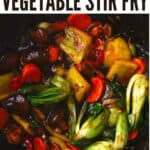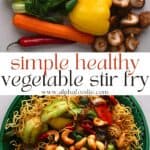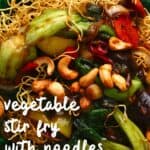This post may contain affiliate links. Please read our disclosure policy.
This healthy vegetable stir-fry with noodles (or other grains) combines a blend of colorful veggies (practically any veggie you like) in a sweet and savory Asian stir-fry sauce with noodles for a quick, nutritious, and delicious 20-minute meal!
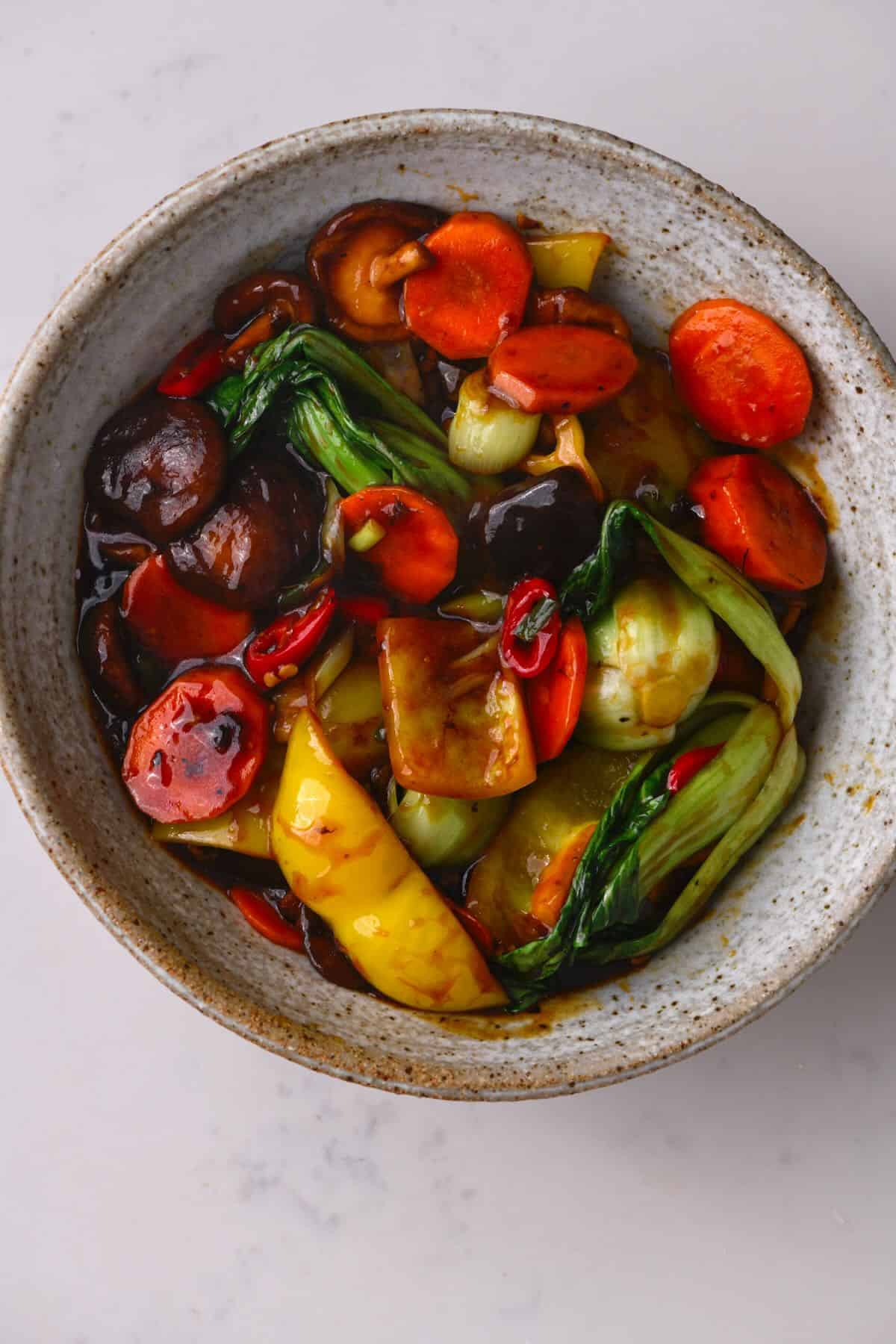
Similar to my previously posted simple vegetable lo mein (chili garlic noodles with veggies), this easy vegetable stir-fry is a super versatile dish, perfect for clearing out your pantry/crisper drawer. While I’ve used a combination of mushrooms, bell pepper, bok choy, and carrot, there’s practically no end to the vegetables you can add to this veggie stir fry recipe. More so, serve the vegetable stir fry with noodles and the protein of your choice for a flavorful, nutrient-dense meal in under 20 minutes!
Stir-fried mixed vegetables are perfect for the end of the week, when you’re struggling with ideas for dinner, have odds and ends of veggies left in your kitchen (a stir-fry can even bring life back to those veggies that are looking a little limp!), and want a low-fuss, high reward meal. With a mixture of colors, texture, and a sweet and savory vegan stir-fry sauce with garlic and ginger, this will become a family favorite!
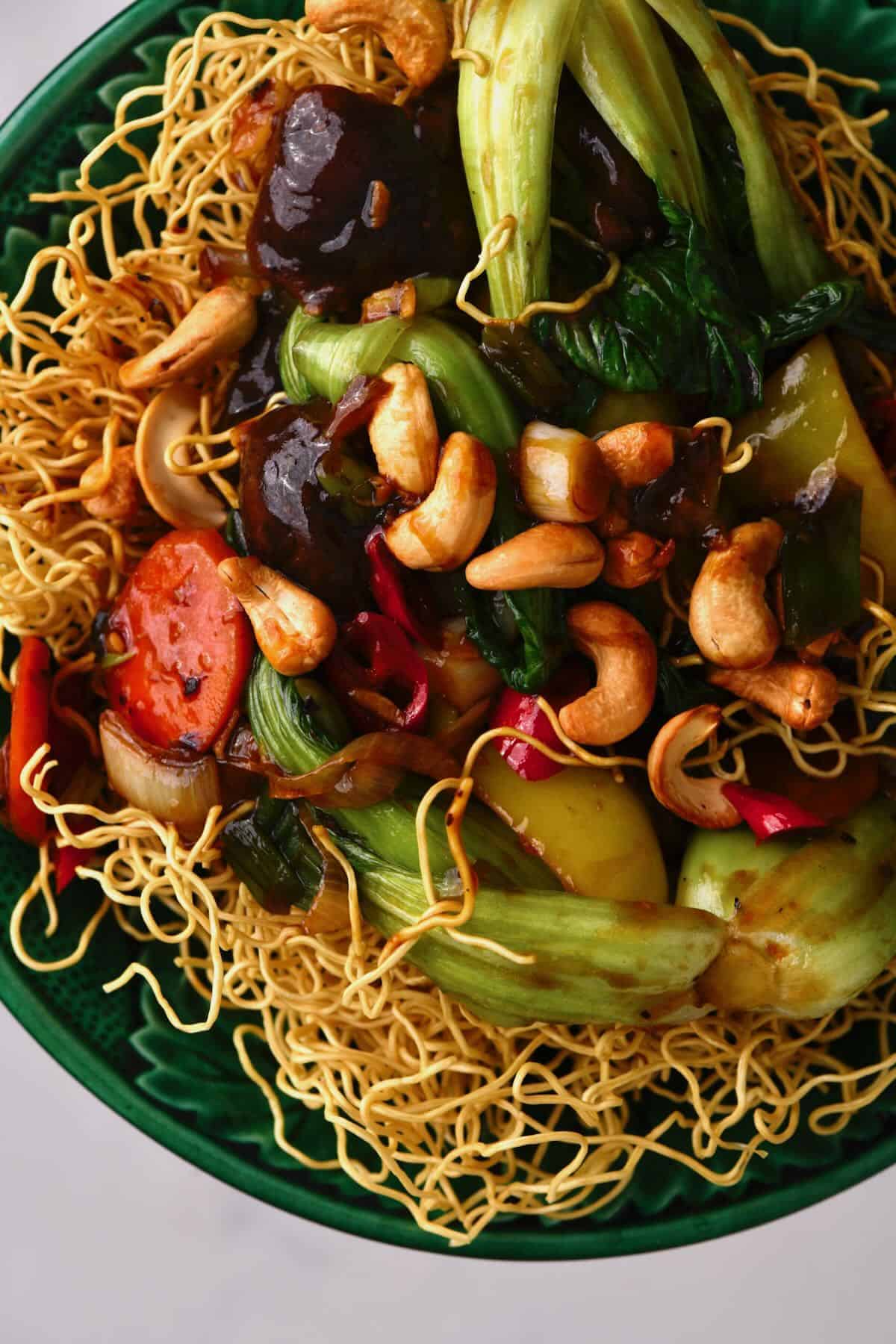
As a bonus, stir-fried vegetables with noodles also work wonderfully at tamping down Asian takeout cravings (which won’t be anywhere near as healthy thanks to the abundance of oil and MSG). Even better, they can be made ahead and refrigerated, frozen, and reheated well.
For more Asian noodle dishes, you might enjoy this chicken ramen noodle soup or this japchae Korean glass noodles!
Want to save this recipe?
The Vegetable Stir Fry Ingredients
The base for these easy stir-fried vegetables requires vegetables and just a handful of additional ingredients, including:
- Mixed vegetables: I used a combination of mushrooms, bell pepper, bok choy, and carrot. Refer to the “Add-ins” Section below for several other options, but you can throw almost anything you have to hand in this simple veggie stir fry recipe.
- Green onion: also called spring onion/scallions.
- Oil: use a neutral cooking oil like vegetable oil or “stir fry oil.”
- Cashews: technically optional, but a few cashews (or other nuts like almonds) to top the vegetable stir-fried noodles add wonderful flavor and crunch. Use raw unsalted cashews and pan-fry in a dry pan until toasted (2-3 minutes, usually).
- Noodles: (optional) I love serving this healthy vegetable stir-fry with noodles. Choose your noodles of choice (regular, egg noodle, rice noodle, vermicelli, brown rice noodle, etc.). Alternatively, serve with grains (rice, quinoa, etc.) or with low-carb cauliflower rice.
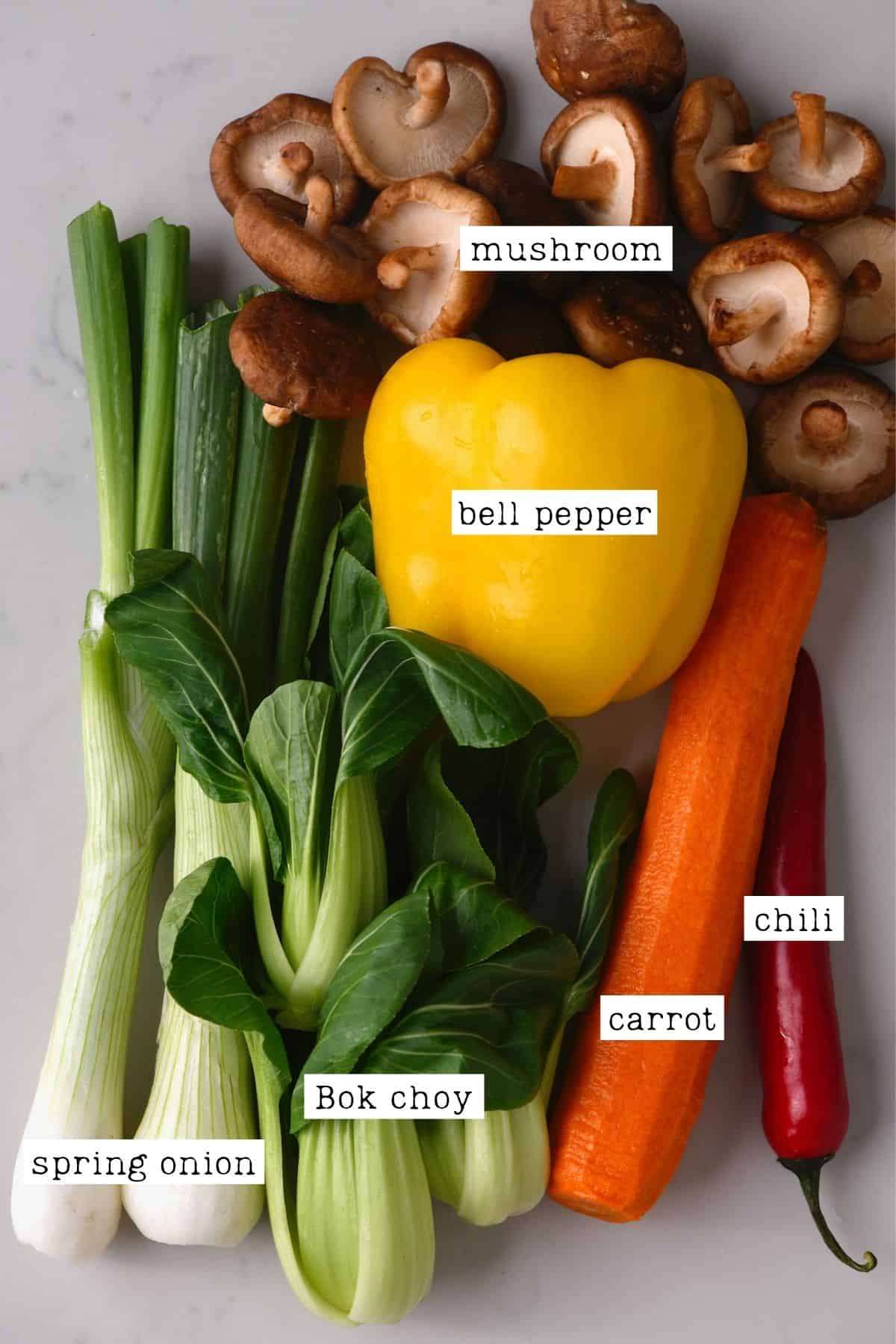
Vegan Stir Fry Sauce
This teriyaki-inspired vegan stir-fry sauce combines classic Asian flavors for a simple but aromatic vegetable stir fry with noodles.
- Soy sauce: dark soy sauce will provide the best flavor. However, you can use low-sodium soy sauce if preferred. For a gluten-free option, use tamari/coconut aminos.
- Sesame oil: this fragrant oil will add tons of depth of flavor to the stir fry veggies.
- Water: to create more of a “sauce” for the vegetable stir-fried noodles. For more flavor, use low-sodium vegetable stock.
- Cornstarch: to thicken the stir-fry sauce. Arrowroot will also work.
- Aromatics: this teriyaki-style vegan stir-fry sauce uses a combination of garlic and ginger (fresh or garlic paste/ginger paste).
- Chili: I used a finely sliced chili. Alternatively, you could use chili paste, chili sauce (or sriracha), or red pepper flakes. Adjust the amount to taste or omit entirely.
- Brown sugar: alternatively, maple syrup would work (or honey if you aren’t vegan).
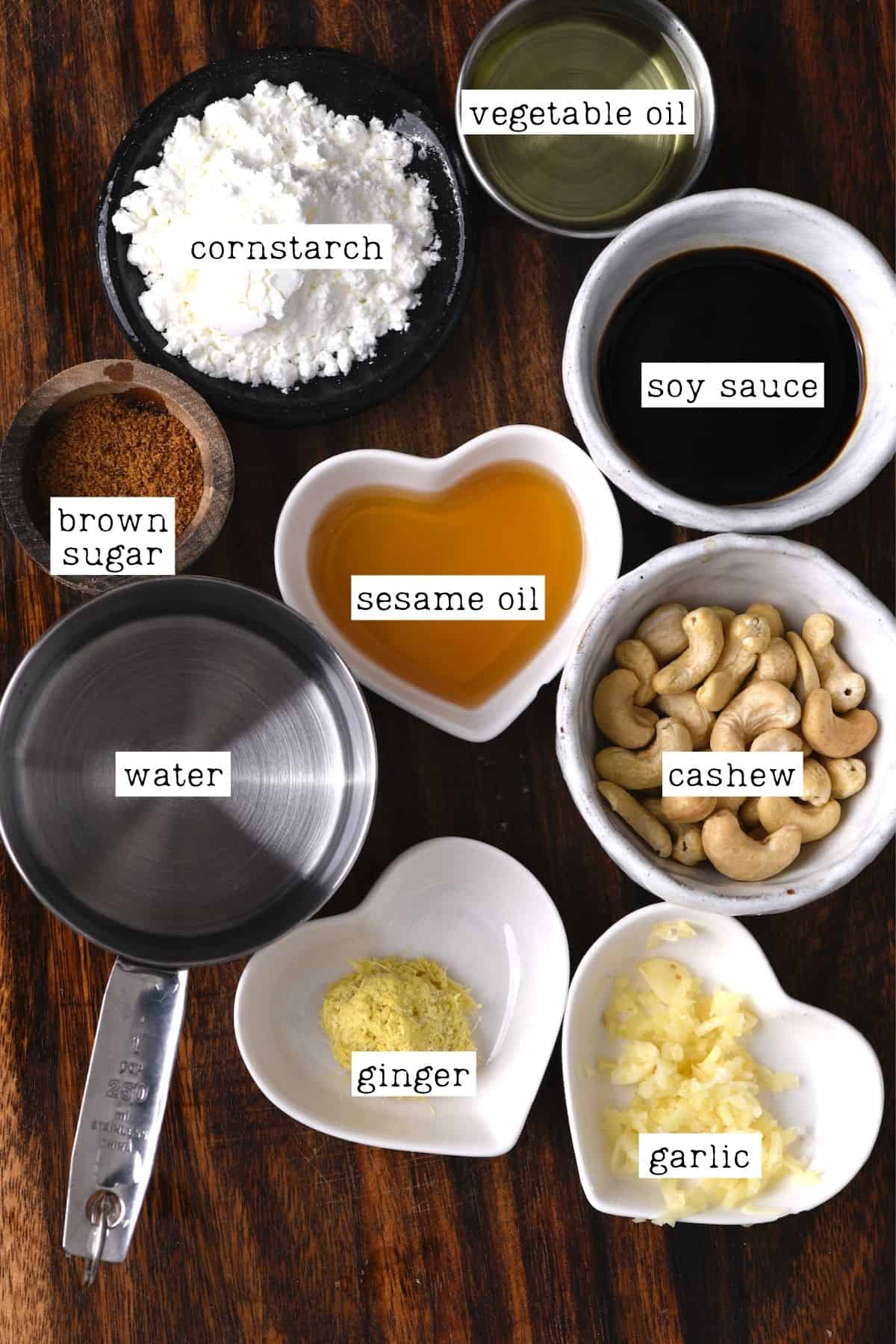
Optional Add-ins and Variations
One of the best things about stir-fries is their “clear out the fridge/pantry” ability. For that reason, there are tons of ways you can adapt the vegetable noodle stir fry based on what you have available to you. Here are just a few suggestions for inspiration.
- Mirin: add a splash of mirin to the stir-fry sauce for extra depth of flavor.
- Sesame seeds: sprinkle over the stir fry veggies raw, or lightly toast in a dry pan until fragrant first.
- Protein: easily turn this veggie stir fry recipe into a complete meal with the addition of your protein of choice: chicken, beef, shrimp, or tofu/tempeh work well. Seitan chick’n should also work within this vegetable stir-fried noodles. Or even tofu ground beef.
- Legumes: alongside the above, you can also boost the protein content in this veggie stir fry recipe with legumes like kidney beans, white beans, or chickpeas (I prefer the former).
- Other vegetables: there are many to choose from, including cabbage, zucchini, leek, sugar-snap peas, broccoli, green beans, snow peas, baby corn, broccoli, onions, mange tout, Brussel sprouts, asparagus, squash, etc.
- Bean sprouts: these add a ton of bulk and texture to vegetable stir-fried noodles.
- Water chestnuts: will add a soft crunch for extra texture (and not much flavor).
- Other grains: instead of noodles, you could serve these mixed stir-fried vegetables with fluffy brown rice, perfect quinoa, crispy noodles, cauliflower rice, etc.
How to Make Vegetable Stir Fry with Noodles?
Step 1: Mise en Place
First, prepare the vegetables. Wash and dry them well. Then finely slice (or dice) the bell pepper, julienne, or thinly slice the carrot (peel first if preferred) and chili, and chunkily slice the spring onions. Depending on the size of your mushrooms, leave them whole or slice them into smaller pieces.
At the same time, mince or grate the ginger and garlic (unless you’re using pre-prepared ginger/garlic paste).
At this point, I also like to measure out all my vegan stir-fry sauce ingredients so they’re ready to go when needed.
Step 2: Stir-Fry the Vegetables
Heat your oil of choice over medium-high heat in a large skillet or wok. Once hot, add the garlic, ginger, and chili, and stir-fry for a minute.
If you’re planning to add noodles to the dish, you can also prepare them now according to their package instructions.
Then, add the chopped vegetables (not including the bok choy), and cook for several minutes (usually 3-4) until they’re beginning to become tender.
The exact time to cook the vegetables will vary but shouldn’t take more than a few minutes for tender-crisp results. For more tender results, they’ll need longer.
Then, add the green onions and stir fry for 20 seconds before adding the bok choy and cooking until tender. I left mine whole, but feel free to break the bok choy up into individual “leaves” if preferred.
Step 3: Add the Vegan Stir Fry Sauce
In a small bowl, whisk together all the sauce ingredients until lump-free.
Then pour it over the healthy vegetable stir fry and cook for an extra minute or two until the sauce thickens.
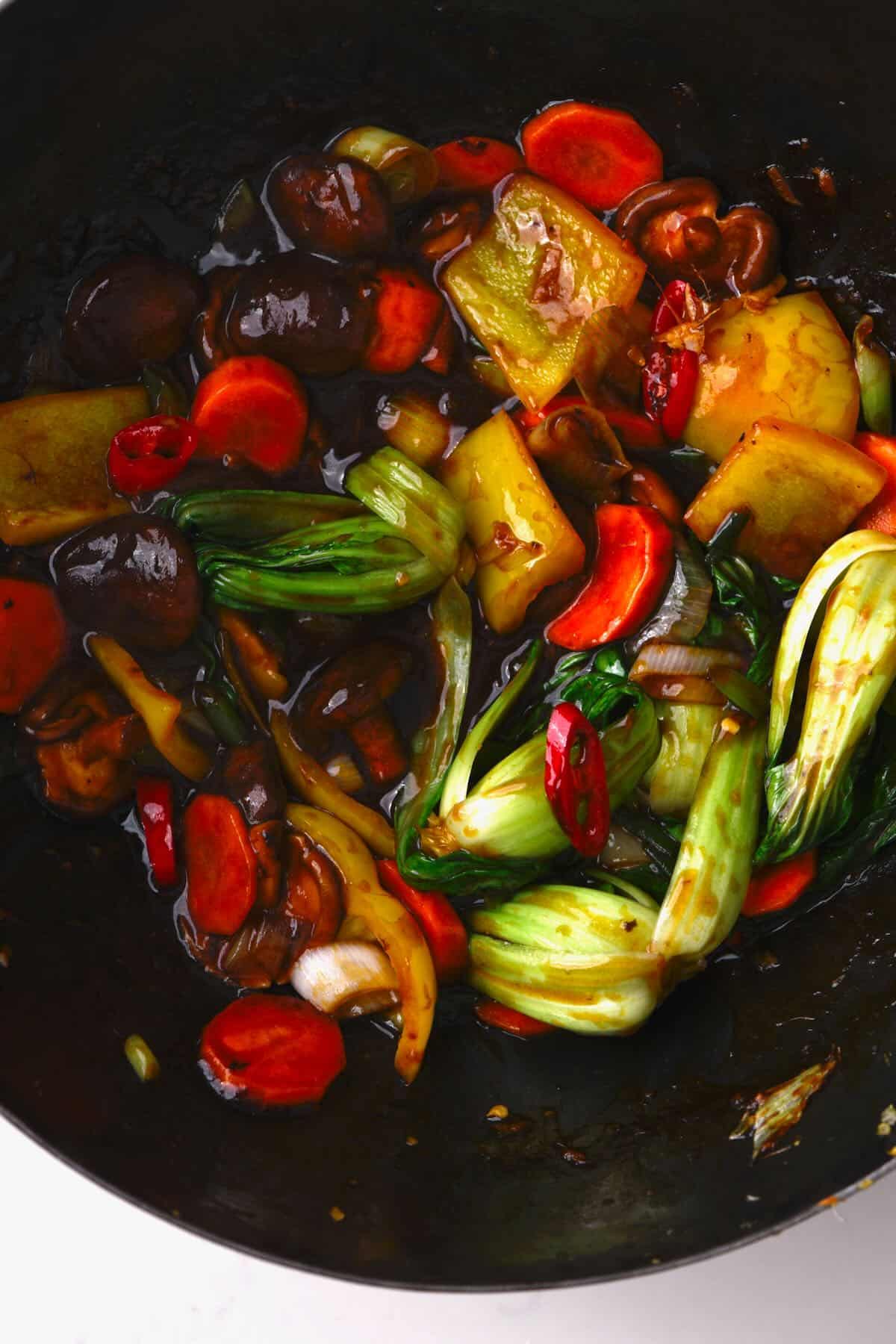
Finally, if you want to, add in your noodles and toss them to coat in the sauce (or if they require stir-frying, add when needed, before adding the sauce). Alternatively, you can serve the stir-fried veggies over the noodles or your choice of grain/side.
How to Meal Prep Vegetable Stir Fry?
There are several ways you can meal prep this veggie stir fry with noodles, including:
- As a freezer meal: blanch, dry, and freeze (for several months) your mixed stir-fry vegetables ready to chuck in a wok/skillet whenever you want a stir-fry.
- Prepare the vegetables: you can wash, dry, and chop your veggies a couple of days in advance and store them in an airtight container/bag in the refrigerator, ready to cook when needed.
- Prepare the sauce: simmer the vegan stir-fry sauce in a small saucepan until thickened, then cool and store in an airtight container in the fridge for up to 3 days.
- Meal prep meals: if you plan to spread the vegetable stir-fried noodles over several days, I recommend cooking the stir-fry to about 75%, removing any meal-prep portions, and then continuing to cook the portion you plan to eat at once. That way, you won’t overcook the vegetables (and/or noodles) when reheating the dish.
With the vegetables and sauce prepped, you can pull together a simple veggie stir fry with noodles in practically 5 minutes!
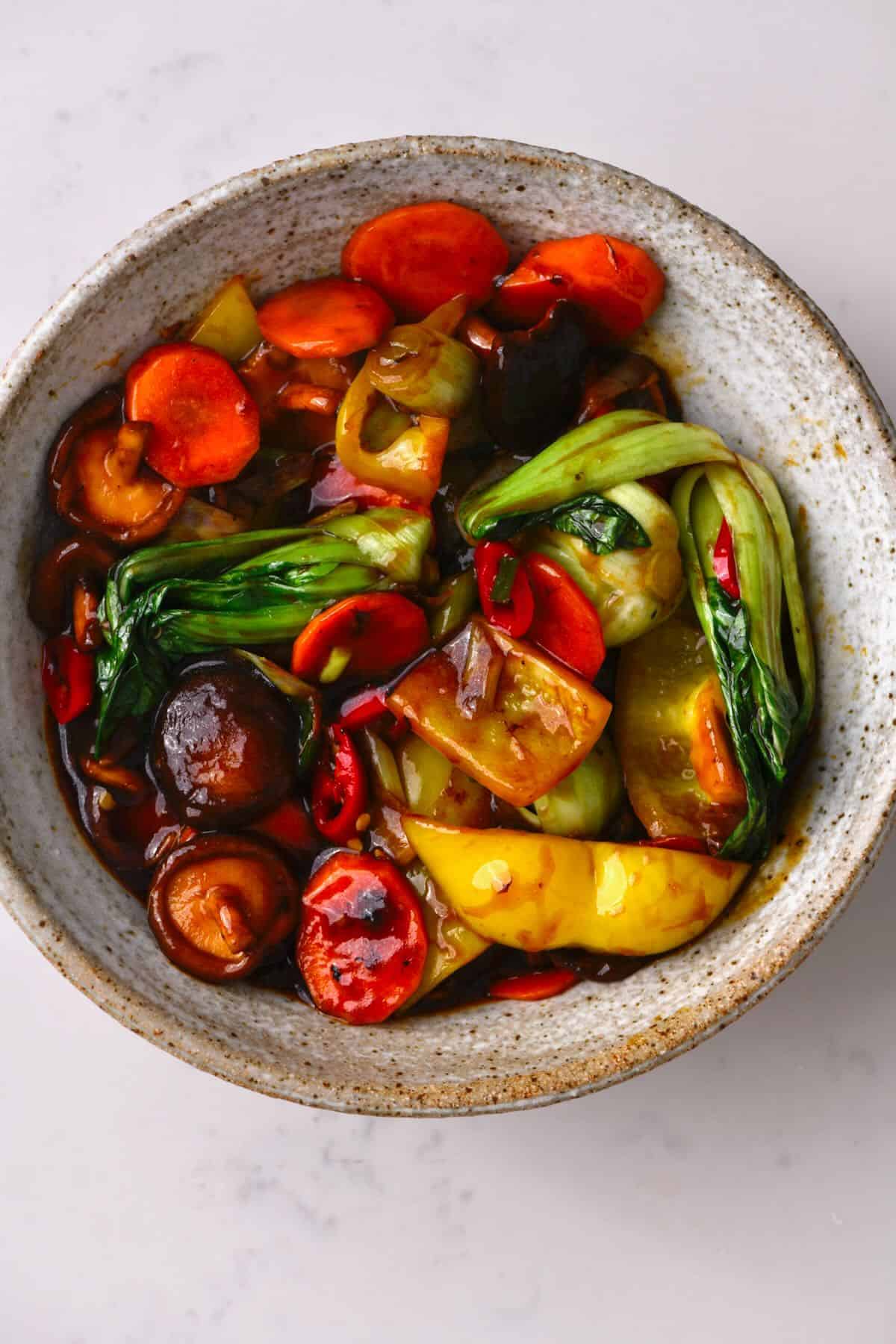
How to Store and Reheat
Store: once cooked, allow the veggie stir fry to cool, and then store in an airtight container in the refrigerator for 3-4 days.
Freeze: while it’s possible to freeze the stir fry veggies, it can affect the texture of the vegetables upon thawing (it works best when the veggies are more on the firm vs. tender side). If you want to freeze it, I recommend doing so for up to a month only for the best taste/texture. Then thaw in the fridge before reheating.
Reheat: there are two main ways I reheat my vegetable stir fry (with noodles) based on the texture I’d prefer. The first is in the microwave (which provides softer results). Alternatively, you can reheat it in a large skillet/wok with a small amount of additional oil.
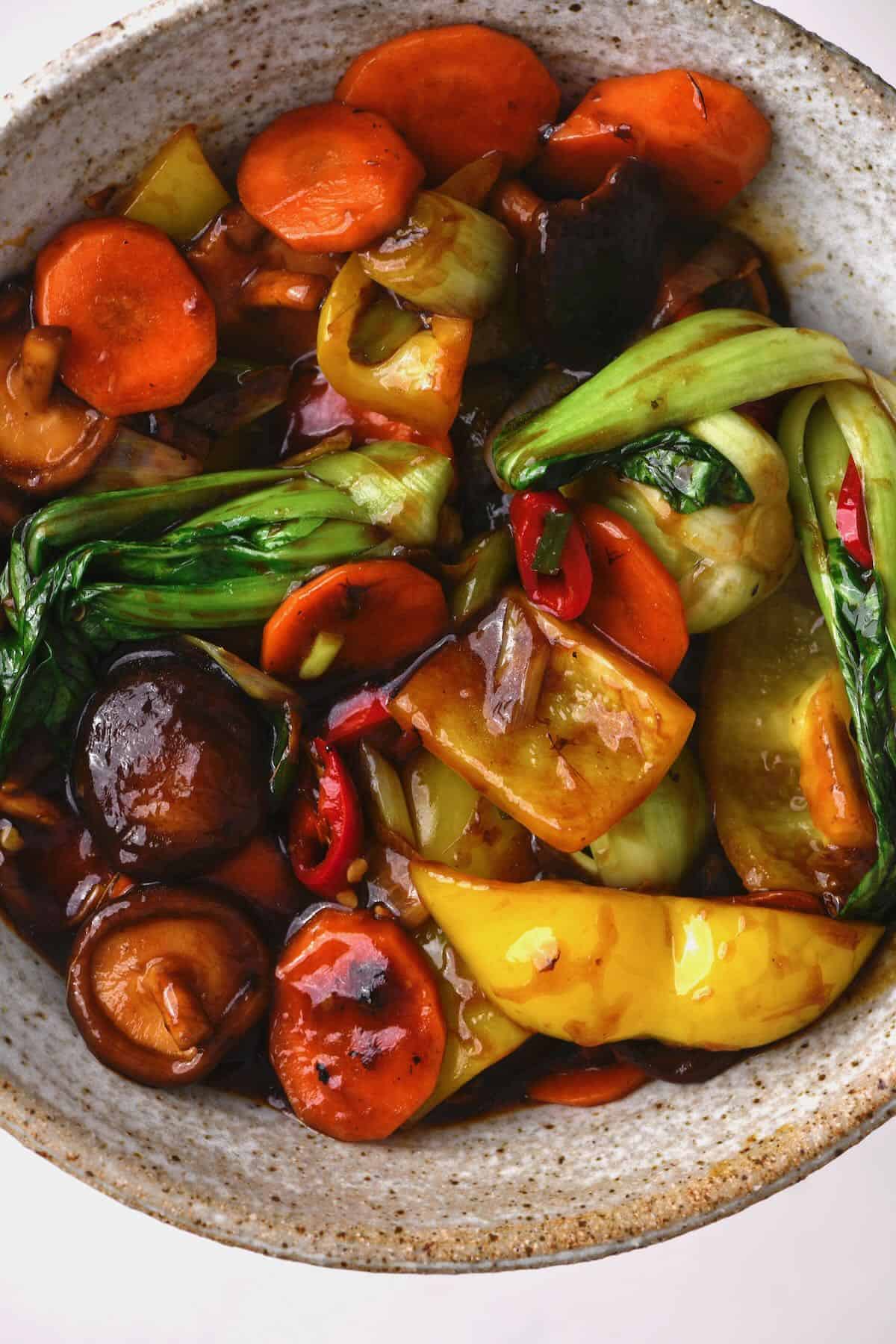
FAQs
Other great options include rice, quinoa, fried rice, crispy noodles, zoodles (or other veggie noodles), cauliflower rice, or even serve the stir-fried mixed vegetables over a bed of greens like spinach or kale.
Absolutely! With a varied combination of lightly cooked vegetables (thus retaining more nutrients than other cooking methods), this simple veggie-heavy dish is packed with nutrients and antioxidants. As long as you keep the oil to minimal amounts are don’t go crazy with the amount of sauce added (which is where the majority of sugar/sodium, etc., are added), then a vegetable stir fry with noodles is an incredibly healthy and nutritious meal.
Of course, though, the vegetables will need additional time in the wok to cook off the extra ice/moisture. It may also naturally thin your sauce more because of the extra moisture.
If you want to add any ingredients like potato, squash, or root veggies, then these should be pre-cooked. Likewise, I prefer to blanch broccoli and cauliflower (and sometimes the carrots too); otherwise, they remain VERY crisp after only 3-4 minutes of stir-frying. If you’re using noodles that require boiling, chuck the broccoli/cauliflower in with them, and they’ll be good to go!
I use a general rule which is: aromatics first, then hard vegetables or veggies that need to sweat (carrots, onions, mushrooms), softer veggies (bell peppers, cabbage, peas/beans, zucchini), and then delicate leafy greens (bok choy, spinach, kale).
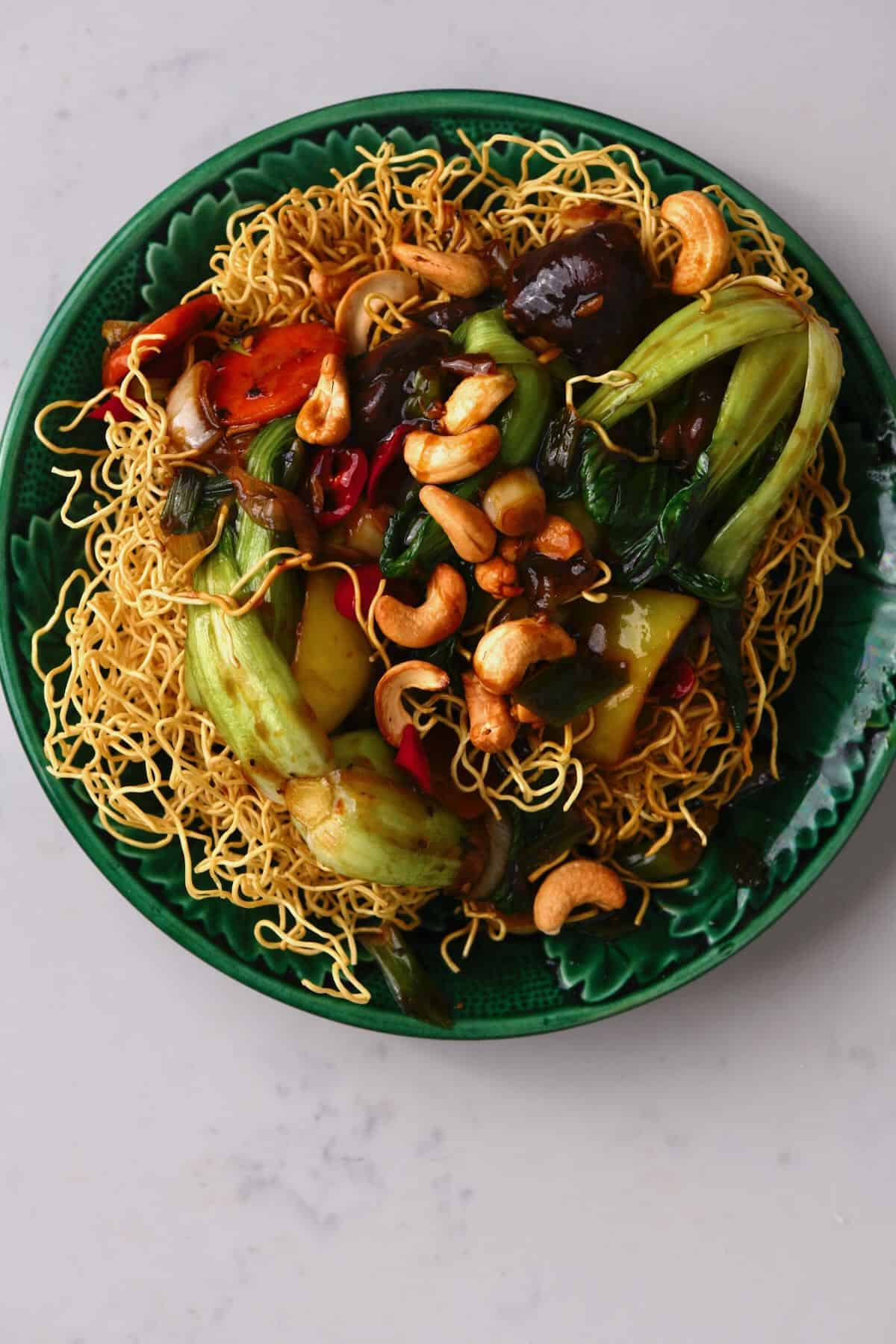
Recipe Tips and Notes
- Use a combination of textures: it’s a good idea to select a combination of vegetables that will be tender-crisp vs. softer once cooked (i.e., broccoli and mushrooms). It has a better mouthfeel but also works best when reheating the stir-fry.
- Add vegetables incrementally: if you’re using a combination of veggies that cook at different times, add them incrementally to the wok (for example, carrots and onions take some time to cook, and mushrooms need time to release their water – so they’d go in first. Meanwhile, peppers and peas cook quickly, and leafy greens, including bok choy, can be added towards the end). That way, nothing becomes overcooked.
- Chop the vegetables evenly: if they’re in even-sized pieces, they’ll cook evenly too. However, the exception to that rule is with veggies that take a lot longer to cook (for example, carrots), which I like to slice very thinly, even if other veggies are cut into more chunky pieces.
- To save on prep time: you could also purchase pre-prepared stir-fry vegetable packets.
- For a thinner/thicker stir-fry sauce: adjust the amount of cornstarch you add.
- Use a large enough pan: if the vegetables are too crowded, they’ll steam rather than stir-fry. Give them plenty of room to cook properly.
- Don’t add the sauce too early: or you’ll find it disappears into the dish. Instead, add it at the end, so it’s wonderfully saucy.
More Mixed Vegetable Dishes
- Mediterranean roasted vegetables
- Greek stuffed vegetables with rice
- Mixed vegetable pilaf
- The Best Eggplant Stew
- Crispy vegetable fritters
- 5 Minute Sautéed Sugar Snap Peas
If you try this easy, healthy vegetable stir fry with noodles recipe, I’d love to hear your thoughts/questions below. Also, I’d appreciate a recipe card rating below, and tag me in your recipe recreations on Instagram @Alphafoodie!
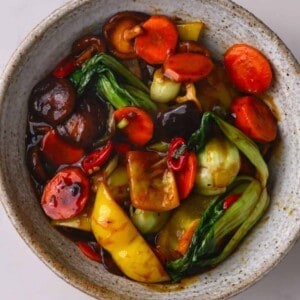
Simple Vegetable Stir Fry with Noodles
Ingredients
- 8 oz mushroom leave whole or slice, based on size
- 1 bell pepper either thinly sliced or cubed
- 1 carrot thinly sliced
- 1 chili pepper thinly sliced (de-seeded) OR chili paste/sauce, or chili flakes
- 2 spring onions scallions/green onions, thickly chopped
- 2 Bok choy leave whole, or separate into leaves
- 1 Tbsp vegetable oil or other neutral cooking oil
…OR use vegetables of your choice!
For the Sauce
- 2 Tbsp cornstarch or arrowroot
- 1 Tbsp soy sauce dark soy for best flavor, reduced-sodium if preferred, or tamari/coconut aminos for gluten-free option
- 2 tsp sesame oil
- 1 tsp brown sugar or maple syrup
- 1 cup water or low sodium vegetable stock
- 0.2 oz ginger minced or paste
- 0.2 oz garlic minced or paste, or 1 clove
- 1 Tbsp cashews or almonds, raw or lightly toasted (unsalted)
Check the Recipe Notes below for optional add-ins and variations!
Instructions
Step 1: Mise en Place
- Prepare the vegetables. Wash and dry them well. Then finely slice (or dice) the bell pepper, julienne or thinly slice the carrot (peel first if preferred) and chili, and chunkily slice the spring onions. Depending on the size of your mushrooms, leave them whole or slice them into smaller pieces.
- At the same time, mince or grate the ginger and garlic (unless you’re using pre-prepared ginger/garlic paste).
- At this point, I also like to measure out all my vegan stir-fry sauce ingredients so they’re ready to go when needed.
Step 2: Stir-Fry the Vegetables
- Heat your oil of choice over medium-high heat in a large skillet or wok. Once hot, add the garlic, ginger, and chili, and stir-fry for a minute.If you’re planning to add noodles to the dish, you can also prepare them now according to their package instructions.
- Add the chopped vegetables (not including the bok choy), and cook for several minutes (usually 3-4) until they’re beginning to become tender.The exact time to cook the vegetables will vary but shouldn't take more than a few minutes for tender-crisp results. For more tender results, they'll need longer.
- Add the green onions and stir fry for 20 seconds before adding the bok choy and cooking until tender. I left mine whole, but feel free to break the bok choy up into individual ‘leaves’ if preferred.
Step 3: Add the Vegan Stir Fry Sauce
- In a small bowl, whisk together all the sauce ingredients until lump-free.
- Pour it over the healthy vegetable stir fry and cook for an extra minute or two until the sauce thickens.Finally, if you want to, add in your noodles and toss them to coat in the sauce (or if they require stir-frying, add when needed, before adding the sauce). Alternatively, you can serve the stir-fried veggies over the noodles or your choice of grain/side.
How to Store and Reheat
- Store: once cooked, allow the veggie stir fry to cool and then store in an airtight container in the refrigerator for 3-4 days.Freeze: while it's possible to freeze the stir fry veggies, it can affect the texture of the vegetables upon thawing (it works best when the veggies are more on the firm vs. tender side). If you want to freeze it, I recommend doing so for up to a month only. Then thaw in the fridge before reheating.Reheat: there are two main ways I reheat my vegetable stir fry (with noodles) based on the texture I’d prefer. The first is in the microwave (which provides softer results). Alternatively, you can reheat it in a large skillet/wok with a small amount of additional oil.For meal prep/make-ahead instructions, check the blog post!
Notes
- Use a combination of textures: it’s a good idea to select a combination of vegetables that will be tender-crisp vs. softer once cooked (i.e., broccoli and mushrooms). It has a better mouthfeel but also works best when reheating the stir-fry.
- Add vegetables incrementally: if you’re using a combination of veggies that cook at different times, add them incrementally to the wok (for example, carrots and onions take some time to cook, and mushrooms need time to release their water – so they’d go in first. Meanwhile, peppers and peas cook quickly, and leafy greens, including bok choy, can be added towards the end). That way, nothing becomes overcooked.
- Chop the vegetables evenly: if they’re in even-sized pieces, they’ll cook evenly too. However, the exception to that rule is with veggies that take a lot longer to cook (for example, carrots), which I like to slice very thinly, even if other veggies are cut into more chunky pieces.
- To save on prep time: you could also purchase pre-prepared stir-fry vegetable packets.
- For a thinner/thicker stir-fry sauce: adjust the amount of cornstarch you add.
- Use a large enough pan: if the vegetables are too crowded, they’ll steam rather than stir-fry. Give them plenty of room to cook properly.
- Don’t add the sauce too early: or you’ll find it disappears into the dish. Instead, add it at the end, so it’s wonderfully saucy.
- Mirin: add a splash of mirin to the stir-fry sauce for extra depth of flavor.
- Sesame seeds: sprinkle over the stir fry veggies raw, or lightly toast in a dry pan until fragrant first.
- Protein: easily turn this veggie stir fry recipe into a complete meal with the addition of your protein of choice; chicken, beef, shrimp, or tofu/tempeh work well. Seitan chick’n should also work within this vegetable stir-fried noodles.
- Legumes: alongside the above, you can also boost the protein content in this veggie stir fry recipe with legumes like kidney beans, white beans, or chickpeas (I prefer the former).
- Other vegetables: there are many to choose from, including cabbage, zucchini, leek, sugar-snap peas, broccoli, green beans, snow peas, baby corn, broccoli, onions, mange tout, Brussel sprouts, asparagus, squash, etc.
- Bean sprouts: these add a ton of bulk and texture to vegetable stir-fried noodles.
- Water chestnuts: will add a soft crunch for extra texture (and not much flavor).
- Other grains: instead of noodles, you could serve these mixed stir-fried vegetables with rice, quinoa, crispy noodles, cauliflower rice, etc.
Nutrition
Nutrition information is automatically calculated, so should only be used as an approximation.




